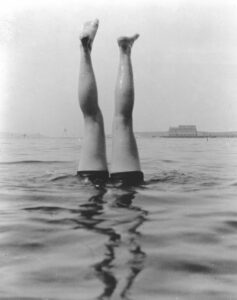You know already that this is an odd and special place. It’s one reason we — and others before us — figured Outer Cape Cod needed its own newspaper. All of us at the Independent think about that fact every week as we write and edit. Part of what’s special about the news, arts, and culture here is the intense presence of history, even though we leave much of it out of our stories most weeks.

A year ago, in our final publication of 2023, we decided to forgo current news entirely and devote an entire issue to plumbing that history. We asked Adam Moss, the former editor of New York magazine and a most welcome visitor in our newsroom, for advice on how to approach it, and he came up with a fine idea: what we were talking about, he said, was perhaps nostalgia more than history. And he suggested looking at nostalgia as a double-edged phenomenon, one that’s not just a sentimental longing for days gone by but also a way of avoiding uncomfortable truths about the past.
Our writers, artists, and designers produced a satisfying mix of historical pieces, writing about illustrious Outer Cape people and deeds (like Josephine Del Deo’s successful defense of the Province Lands from development, Maline Costa and his beloved Moors restaurant, and the Finnish immigrants who built saunas all over Wellfleet) as well as the sale of a Black child into slavery in Truro, the crimes of the Puritans against the Indigenous people of this land, and the less than admirable politics of wireless pioneer Guglielmo Marconi, whose name is attached to a Wellfleet beach.
This year, the double-edged appeal of nostalgia seems even more powerful — not surprising, considering the strange and dismaying year we have just completed. In some respects, we have discovered that we’re living in a different country from the one we thought we inhabited.
In fact, the word nostalgia itself has changed its meaning over time and evolved from its original definition as a medical ailment. Most authorities trace its first use to a 1688 dissertation by a Swiss medical student named Johannes Hofer, who described nostalgia as a form of homesickness in soldiers so severe they could literally die from it. “Hofer proposed that nostalgia was ‘sympathetic of an afflicted imagination,’ ” writes Lisa Winter in New Scientist, “caused by ‘continuous vibration of animal spirits’ through certain parts of the brain, and that it ‘admits no remedy other than a return to the homeland.’ ”
It was not until modern times that the definition of nostalgia changed from a disease to sentimentality, writes Sarah Diamond in a New York Times essay about the history of that newspaper’s use of the word. The etymologist Grant Barrett, Diamond writes, “attributed this to ‘semantic weakening,’ a process in which a word loses intensity.”
Words are our stock in trade, our best asset, and we’re not about to let them turn weak in our nostalgia-inspired writing.
“Is it possible to feel nostalgia for a place you’ve never been?” asks John D’Addario in his essay about The Rushes, a gay Provincetown guesthouse that appears to have existed for just a single season in 1986.
Yes, we think it’s possible, and our evidence is the work of our staff writers who dove into the archival records and came out inspired by the stories they found. Aden Choate writes about Miriam Look MacMillan, the wife of the celebrated admiral who is surely familiar to everyone in Provincetown. What our readers might not know is that Miriam traveled with her famous husband to the Arctic and demonstrated intrepidness and courage that was equal to his.
William von Herff, who besides his environmental reporting is our birding columnist, tells the story of Eastham’s Irma Penniman, who saved endangered hawks from hunters in Pennsylvania at a time when game wardens were sometimes murdered for doing such work. Parker Mumford writes about the fate of the last surviving members of pirate Sam Bellamy’s crew after the famous wreck of the Whydah off Wellfleet.
Dorothea Samaha was fascinated by the story of Daniel Hiebert, Provincetown’s eccentric and beloved doctor for more than 50 years. His may be a familiar story to many locals — some of whom, like Mel Joseph and Betty White, were patients of Dr. Hiebert — but for a writer who is new to town and learning to navigate its hidden corners, there is a kind of magic in discovering such near-legend.
These stories provide the texture and context that explain our sense that the Outer Cape is different from anyplace else. They give new meaning to the everyday stories in next week’s news columns.
On the nostalgia front, you will find both a bit of disease and a good dose of sentiment in these pages — the former, I suppose, in Norman Mailer’s drinking (“Why don’t you sober up?” the good Dr. Hiebert told Mailer after stitching up the back of the writer’s head, which had been clubbed by a Provincetown cop).
For sentiment, I recommend Lisbeth Wiley Chapman’s memory of a rainy July evening in 1960 at Murray’s Pharmacy on Main Street in Wellfleet, wherein the pharmacist struts down the aisle with “Let Me Entertain You” on the stereo.
And then there is Paul Benson’s evocation of the legendary Piggy’s Dance Bar on Shank Painter Road, a place that everyone has heard stories about and those of us who never got to go there feel intense nostalgia for. Paul’s history is perfectly paired with Arnie Charnick’s prose poem, “Dance Fever,” about Howie Gruber, the “diminutive dude” who was Charnick’s favorite dance partner at Piggy’s, where they spent many a late night “zigging and zagging betwixt the hive of high and happy humans.”
Thank you, Arnie. For an editor absorbed in fixing sentences that don’t quite work, it’s a rare pleasure to be given a piece of writing with invented spelling and unconventional grammar that does what it sets out to do perfectly. It’s the opposite of “semantic weakening” — it’s forging everyday words into unforgettable images.



